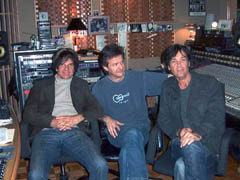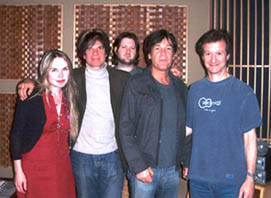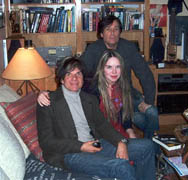Mary
Fahl’s Dark Side of the Moon: A Backgrounder
| “What,
are we crazy? What are we even thinking?”
Time and again, the same questions, and at each and every stage
of the process, the logic, the rightness of the choice affirmed
itself.
Why
take on the monumental project of “re-imagining”
Pink Floyd’s mythic 1973 magnum opus, Dark Side of
the Moon?
First, take an artist, Mary Fahl, critically acclaimed for her
work with The October Project, possessing the kind of vocal
gifts that the LA Times had described as “a striking
voice with its wide range” and “rich, full bodied
amplitude”—yet unfulfilled in the wake of her first
solo album, The Other Side of Time (Sony Classical),
not at all interested in doing another “singer-songwriter
album,” searching for new challenges, burning to express
herself and longing for something that might attain what she
envisioned as the “passion and grandeur of opera.”
Enter
a new manager, Steven Saporta, proffering a bold producer for
her next album like David Werner, both of them interested in
“reinterpreting” an entire classic album. But still,
an album that qualifies as one of the great monuments of rock
history?—as overwhelming aesthetically as it is commercially(
Billboard’s Top 200 for 14 straight years)? |

L-R: Mark Doyle, Bob Clearmountain,
& David Werner at MixThis!
|

L-R: Mary Fahl, Mark Doyle,
Brandon Duncan (assistant), David Werner, and Bob Clearmountain
at MixThis!
|
Next,
pair them together with Mark Doyle, Werner’s old band mate
and a virtuoso guitarist, keyboardist, producer and arranger in
his own right, with his own studio in upstate New York. As it
turned out, Fahl, Werner and Doyle had much in common. All three
of them were disillusioned by the state of pop music and its increasingly
stultifying corporate ambience. All three of them were deeply
disturbed by what was happening in the world. And all three of
them had come of age at the time when Pink Floyd’s Dark
Side of the Moon represented the pinnacle of creativity and
freedom and sense of purpose. All of them felt that the album’s
timeless themes--of the faults of humanity and the pressures of
modern life, insanity, mortality, religion, society and conflict—were
vitally relevant to their own experience of today’s world.
“It’s the Holy Grail,” comments Fahl, “
no question about it. It’s so damn great as a work of art,
so much more than just a product of its time, but I had a lot
of trepidation.”
Not surprisingly; the challenges were nothing less than overwhelming.
First, as Fahl describes it, “half of the album is instrumental,
with all kinds of sound collage, what was I going to do about
that?” Yes, DSOM is certainly full of electronics, technology,
synthesizers, and space—and then there was the issue of
the intention of the project itself. As Werner explains, “We
had to have a reason to make this ours. None of us were interested
in just trying to make good versions of great songs--there are
Pink Floyd tribute bands for that. But if we could re-invent
the intention for ourselves, then we might stand a chance of
being able to rediscover something that could give it a new
life of its own.”
Fahl decided to “put one toe in the water” and they
traveled to Doyle’s studio outside of Syracuse to take
a whack at “Us and Them”—the very Roger Waters
composition that had kicked off the project for Pink Floyd.
For Mark Doyle, “The song has a healing message, so it
seemed like the spiritually correct place to begin. The hardest
thing was to start. The feeling was, Leap, and the net will
appear--”
So
leap they did, and the net appeared when Fahl used a chant from
the Bhagavad-Gita—“the same one that Robert
Oppenheimer, who was also a Sanskrit scholar, had used when
he first beheld the atomic bomb: ‘I have become death,
the destroyer of worlds,’” she relates. “It
just seemed to fit.”
At
that point Werner knew that they were on their way. “I
thought, wow, this is interesting, she can interpret this whole
album this way. Why can’t Mary be the sequencers
and saxophone? Why can’t this woman interpret not only
the lyrics but these musical passages? She’s
not going to play any instrument on this record, yet she’s
going to play everything.”
|
| And
so began their step-by-step, song-by-song scaling of the musical
Mt. Everest that is Dark Side of the Moon, every moment
an exercise in humility, respect, awe, economy, and pure experimentation.
First and foremost, it was always about the simple organic process
of the three of them working together in Doyle’s small studio.
Says Doyle, “Once we got in the door with ‘Us and
Them,” the feeling was let’s just go through the songs,
one by one--just put one foot in front of the other and let the
inspiration come. Thinking about trying to do all ten songs was
nuts, just too much. So let’s just start with ‘Breathe’”…
All
three brought different dimensions and interpretations of the
work to the table. Says Doyle, “Talk to David and you’ll
get something political; talk to Mary and you’ll hear
something spiritual; talk to me and you get something musical”—and
yet it was always obvious to them that the project would flourish
only to the degree that they stayed viscerally connected to
the emotional essence of the album—“to the very
spirit that fueled it and made it so great,” as Werner
describes it--to the soul of the music, to that part of it that
would forever be about speaking and singing from the heart.
“That’s how we found our way into the record,”
Werner says, “and to each other’s talents at the
same time. We all got very excited about music again.”
For Mary Fahl, DSOM was all about speaking from her
heart, but it was also like leaping off a cliff and free falling
into the deepest depths of her own spontaneous intellect, femininity,
and spirituality. She found herself on an incantatory journey
that saw her speaking in tongues and warbling like Pharoah Sanders
on “Any Color You Like,” turning “Great Gig
in the Sky” into a shamanistic lament, and “Money”
into a hot primal tabla-driven track that conjures sexy belly
dancers—“juicy and yummy,” as Fahl characterizes
it--a unique reading that perhaps only a woman could have brought
to it. By the time she got to “Brain Damage,” the
whole album had become like a Gnostic allegory for her.
“To
me what makes this music so powerful is that it’s this
beautiful song-cycle, that can really be done a thousand different
ways,” Fahl concludes. “I’ve never been the
kind of songwriter who would ever write about these kinds of
things—it all seems much too grand for me—and yet
there I was, feeling the themes of these songs so strongly,
and wanting to say them. Dark Side of the Moon became
my way of expressing it. I’m very proud of it.”
|

L-R: Mark Doyle, Mary Fahl
& David Werner at MixThis!
|
This
site best viewed with Microsoft IE at a screen resolution
of 1024x768 |
|
Designed
and
maintained by: Conan |
|
|